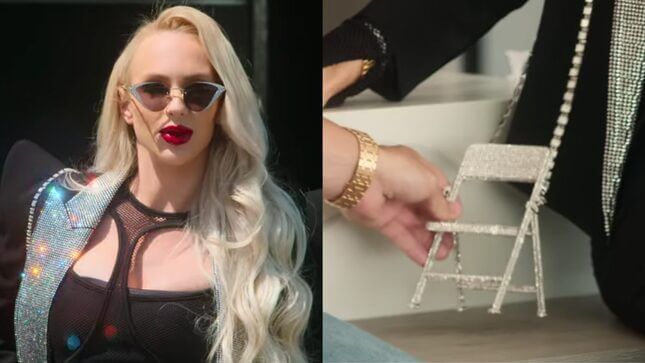Jezebel Investigates: Selling Sunset‘s Scene-Stealing Chair Purse
Christine Quinn holds a little bejeweled folding chair in the new season of Netflix's hit series and calls it a purse. Is it a purse?
EntertainmentTV

Selling Sunset’s fourth season might as well have been called We Need to Talk About Christine, because that’s pretty much all that the Netflix series’ cast did. The luxury real estate agents of the Oppenheim Group discussed Christine Quinn’s pregnancy (and new baby) in tandem with fixating on all of her various feuds, both in and out of the office. All of which was, you know, fine. But there was one Christine Quinn plot point that went shockingly under-discussed: the bedazzled miniature folding chair she wore as a purse.
The chair purse made its appearance in the early minutes of the season premiere. Quinn, nine months pregnant, sporting a Cruella-esque peak-shoulder jacket and looking like a yassified fertility idol, wore it to meet with her boss, Jason Oppenheim, at a listing. After he suggested that the sparkling, six-inch chair dangling off her shoulder was not in fact a purse, Quinn insisted that it was. “It’s a chair purse,” she said, before clarifying, “You don’t hold anything, it’s a fashion statement.”
Exit chair purse from Selling Sunset, but not from my mind, which was wracked with questions. What are its origins? Can a fashion artifact be considered a purse if it’s not supposed to hold anything? And if it’s not a purse, what is it?
So, I consulted some fashion experts to get to the bottom of it all, and they came to a unanimous conclusion: Quinn’s eye-catching accessory is not a purse. “I’d probably call this jewelry or wearable art rather than a purse,” fashion historian Kimberly Chrisman-Campbell wrote Jezebel in an email, “but it’s certainly a humorous commentary on what constitutes a purse.”
-

-

-

-

-

-

-

-

-

-

-

-

-

-

-

-

-

-

-

-

-

-

-

-

-

-

-

-

-

-

-

-

-

-

-

-

-

-

-

-








































